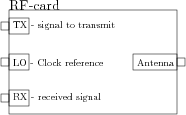Test Configurations
This section describes the sample configurations. Both soft- and hardware-setup is described for each configuration. It is a good starting point for new users.
The following configurations are described here:
- GPS for the reception and storage of a GPS-signal
- Radio demonstrates a simple send/receive-setup
- Radar is a simple game using radar-measurements of a moving ball
- WLAN captures one or more 802.11-packets
Setup
This subsection contains some general overview of the different hardware-subsystems.
RF-cards
Fig. <ref>fig:RF-cards</ref> shows the input/output connectors of the RF cards (power supply omitted).
 |
|
The important connections on a RF-card
(rf-cards.ps) |
Rohde & Schwarz
All settings given in the figures start from a presetted state of the signal-generator or -analyzer. You find a button labeled Preset that sets the machine into a well-known state.
ICS-cards
In the following picture (TODO) you can see the ICS-cards on the back of the computer. All the input and output-labels are visible.
FPGA
As described in section <ref>sec:FPGA</ref>, the FPGA can be programmed with two versions of the code: one for the GPS-reception, and another one for everything else. Please be sure to chose the appropriate code, or the given application will not work.
Refer to section <ref>sec:FPGA</ref> on how to reprogram the PFGA.
Power supply
Wrong settings of the power-supply may destroy the attached hardware, so take care and be sure to follow these instructions:
- Switch up 1 & 2
- Connect the power supply
- Switch down 1
- Adjust voltage and current using 3 & 4
- Switch down 2